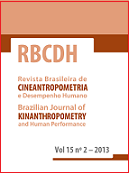Ballroom dance: chronic responses on blood pressure in medicated hypertensives
DOI:
https://doi.org/10.1590/1980-0037.2013v15n2p155Abstract
The importance of physical exercise for patients with systemic hypertension is well established in the literature. However, ballroom dance has been little investigated in this context. The objective of this study was to determine the chronic effect of ballroom dance on blood pressure in medicated hypertensives. The sample was the number of blood pressure measurements obtained during the patients’ participation in the dance program. Thus, 92 blood pressure measurements were taken and divided into four groups: 1) pre-session systolic blood pressure, 2) post-session systolic blood pressure, 3) pre-session diastolic blood pressure, 4) post-session diastolic blood pressure. We used a mercury sphygmomanometer and stethoscope. As measuring protocol, we considered the Brazilian Guidelines. Blood pressure was measured before and after each ballroom dance session. The mean age of the 23 medicated hypertensive patients studied was 62.5 ± 7 years and 34.8% of them were male. Forty sessions were held three times a week, lasting one hour/session. The mean pre-session systolic blood pressure was 131,8 ± 17mmHg and 117,8±13mmHg after the session, with statistically significant difference (p <0.001); in diastolic blood pressure values were 70,7±6mmHg and 67,7±9mmHg (p <0.075). We conclude that ballroom dance can contribute to a better control of blood pressure in medicated hypertensive patients, which may be considered as a cardiac rehabilitation exercise.



